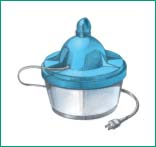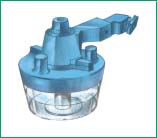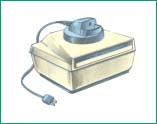Humidifier Therapy
Humidifiers deliver a maximum amount of water vapor without producing particulate water. They’re used to prevent drying and irritation of the upper airway in such conditions as croup, in which the upper airway is inflamed, or in a patient who has particularly thick and tenacious secretions.
Several types of humidifiers are available. (See Types of humidifiers, page 346.) Diffusion humidifiers (also known as in-line humidifiers) are added to oxygen delivery systems to humidify only the air being delivered to the patient. One type of diffusion humidifier—the cascade bubble diffusion humidifier—heats water vapor, which raises the moisture-carrying capacity of gas and increases the amount of humidity delivered to the patient. A diffusion head humidifier can be added to a low-flow oxygen delivery system to humidify the air being delivered to the patient, but it doesn’t heat the water vapor. A heated vaporizer heats water vapor to raise the moisture-carrying capacity of gas, adding humidity to an entire room.
Equipment
Appropriate humidifier ▪ sterile, distilled water (for all types) or tap water (for a heated vaporizer with a demineralizing capability) ▪ container for waste water.
Bedside Humidifier and Heated Vaporizer
Hospital-grade disinfectant.
Diffusion Head Humidifier
Flowmeter ▪ oxygen source.
Preparation of Equipment
For A Bedside Humidifier
Open the reservoir of the bedside humidifier and add sterile, distilled water to the fill line; then close the reservoir. Keep all room windows and doors closed tightly to maintain adequate humidification.
For A Cascade Bubble Diffusion Humidifier
The cascade bubble diffuser should be installed into the ventilator circuit according to the manufacturer’s instructions. Unscrew the cascade reservoir and add sterile, distilled water to the fill line. Screw the top back onto the reservoir. Plug in the heater unit and set the temperature between 95°F (35°C) and 100.4°F (38°C).
Types of Humidifiers
| Description and uses | Advantages | Disadvantages | |
|---|---|---|---|
Bedside humidifier |
|
|
|
Cascade bubble diffusion humidifier |
|
|
|
Diffusion head humidifier |
|
|
|
Heated vaporizer |
|
|
|
For A Diffusion Head Humidifier
Unscrew the humidifier reservoir and add sterile, distilled water to the appropriate level. (If using a disposable unit, screw the cap with the extension onto the top of the unit.) Then screw the reservoir back onto the humidifier, and attach the flowmeter to the oxygen source. Screw the diffusion head humidifier onto the flowmeter until the seal is tight. Then set the flowmeter at a rate of 2 L/minute and check for gentle bubbling. Next, check the positive-pressure release valve by occluding the end valve on the humidifier. The pressure should back up into the humidifier, signaled by a high-pitched whistle. If this whistle doesn’t occur, tighten all connections and try again.
For A Heated Vaporizer
Stay updated, free articles. Join our Telegram channel

Full access? Get Clinical Tree


